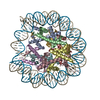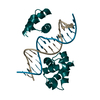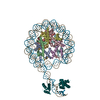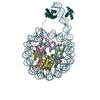+ Open data
Open data
- Basic information
Basic information
| Entry | Database: PDB / ID: 8g8e | |||||||||
|---|---|---|---|---|---|---|---|---|---|---|
| Title | Human Oct4 bound to nucleosome with human LIN28B sequence | |||||||||
 Components Components |
| |||||||||
 Keywords Keywords | DNA BINDING PROTEIN/DNA /  Oct4 / Oct4 /  Nucleosome / LIN28B DNA / iPSC / DNA BINDING PROTEIN-DNA complex Nucleosome / LIN28B DNA / iPSC / DNA BINDING PROTEIN-DNA complex | |||||||||
| Function / homology |  Function and homology information Function and homology informationcell fate commitment involved in formation of primary germ layer / cardiac cell fate determination / POU5F1 (OCT4), SOX2, NANOG repress genes related to differentiation / Formation of the anterior neural plate / endodermal-mesodermal cell signaling /  regulation of asymmetric cell division / endodermal cell fate specification / Specification of primordial germ cells / heart induction / POU5F1 (OCT4), SOX2, NANOG activate genes related to proliferation ...cell fate commitment involved in formation of primary germ layer / cardiac cell fate determination / POU5F1 (OCT4), SOX2, NANOG repress genes related to differentiation / Formation of the anterior neural plate / endodermal-mesodermal cell signaling / regulation of asymmetric cell division / endodermal cell fate specification / Specification of primordial germ cells / heart induction / POU5F1 (OCT4), SOX2, NANOG activate genes related to proliferation ...cell fate commitment involved in formation of primary germ layer / cardiac cell fate determination / POU5F1 (OCT4), SOX2, NANOG repress genes related to differentiation / Formation of the anterior neural plate / endodermal-mesodermal cell signaling /  regulation of asymmetric cell division / endodermal cell fate specification / Specification of primordial germ cells / heart induction / POU5F1 (OCT4), SOX2, NANOG activate genes related to proliferation / Transcriptional regulation of pluripotent stem cells / regulation of DNA methylation-dependent heterochromatin formation / Germ layer formation at gastrulation / miRNA binding / somatic stem cell population maintenance / blastocyst development / anatomical structure morphogenesis / BMP signaling pathway / negative regulation of miRNA transcription / DNA-binding transcription repressor activity, RNA polymerase II-specific / response to wounding / positive regulation of canonical Wnt signaling pathway / sequence-specific double-stranded DNA binding / regulation of asymmetric cell division / endodermal cell fate specification / Specification of primordial germ cells / heart induction / POU5F1 (OCT4), SOX2, NANOG activate genes related to proliferation / Transcriptional regulation of pluripotent stem cells / regulation of DNA methylation-dependent heterochromatin formation / Germ layer formation at gastrulation / miRNA binding / somatic stem cell population maintenance / blastocyst development / anatomical structure morphogenesis / BMP signaling pathway / negative regulation of miRNA transcription / DNA-binding transcription repressor activity, RNA polymerase II-specific / response to wounding / positive regulation of canonical Wnt signaling pathway / sequence-specific double-stranded DNA binding /  regulation of gene expression / regulation of gene expression /  transcription regulator complex / RNA polymerase II-specific DNA-binding transcription factor binding / sequence-specific DNA binding / transcription cis-regulatory region binding / DNA-binding transcription factor activity, RNA polymerase II-specific / RNA polymerase II cis-regulatory region sequence-specific DNA binding / DNA-binding transcription factor activity / transcription regulator complex / RNA polymerase II-specific DNA-binding transcription factor binding / sequence-specific DNA binding / transcription cis-regulatory region binding / DNA-binding transcription factor activity, RNA polymerase II-specific / RNA polymerase II cis-regulatory region sequence-specific DNA binding / DNA-binding transcription factor activity /  ubiquitin protein ligase binding / regulation of DNA-templated transcription / regulation of transcription by RNA polymerase II / negative regulation of transcription by RNA polymerase II / positive regulation of transcription by RNA polymerase II / ubiquitin protein ligase binding / regulation of DNA-templated transcription / regulation of transcription by RNA polymerase II / negative regulation of transcription by RNA polymerase II / positive regulation of transcription by RNA polymerase II /  mitochondrion / mitochondrion /  DNA binding / DNA binding /  RNA binding / RNA binding /  nucleoplasm / nucleoplasm /  nucleus / nucleus /  cytosol / cytosol /  cytoplasm cytoplasmSimilarity search - Function | |||||||||
| Biological species |   Homo sapiens (human) Homo sapiens (human) | |||||||||
| Method |  ELECTRON MICROSCOPY / ELECTRON MICROSCOPY /  single particle reconstruction / single particle reconstruction /  cryo EM / Resolution: 3.9 Å cryo EM / Resolution: 3.9 Å | |||||||||
 Authors Authors | Sinha, K.K. / Bilokapic, S. / Du, Y. / Malik, D. / Halic, M. | |||||||||
| Funding support |  United States, 2items United States, 2items
| |||||||||
 Citation Citation |  Journal: Nature / Year: 2023 Journal: Nature / Year: 2023Title: Histone modifications regulate pioneer transcription factor cooperativity. Authors: Kalyan K Sinha / Silvija Bilokapic / Yongming Du / Deepshikha Malik / Mario Halic /  Abstract: Pioneer transcription factors have the ability to access DNA in compacted chromatin. Multiple transcription factors can bind together to a regulatory element in a cooperative way, and cooperation ...Pioneer transcription factors have the ability to access DNA in compacted chromatin. Multiple transcription factors can bind together to a regulatory element in a cooperative way, and cooperation between the pioneer transcription factors OCT4 (also known as POU5F1) and SOX2 is important for pluripotency and reprogramming. However, the molecular mechanisms by which pioneer transcription factors function and cooperate on chromatin remain unclear. Here we present cryo-electron microscopy structures of human OCT4 bound to a nucleosome containing human LIN28B or nMATN1 DNA sequences, both of which bear multiple binding sites for OCT4. Our structural and biochemistry data reveal that binding of OCT4 induces changes to the nucleosome structure, repositions the nucleosomal DNA and facilitates cooperative binding of additional OCT4 and of SOX2 to their internal binding sites. The flexible activation domain of OCT4 contacts the N-terminal tail of histone H4, altering its conformation and thus promoting chromatin decompaction. Moreover, the DNA-binding domain of OCT4 engages with the N-terminal tail of histone H3, and post-translational modifications at H3K27 modulate DNA positioning and affect transcription factor cooperativity. Thus, our findings suggest that the epigenetic landscape could regulate OCT4 activity to ensure proper cell programming. | |||||||||
| History |
|
- Structure visualization
Structure visualization
| Structure viewer | Molecule:  Molmil Molmil Jmol/JSmol Jmol/JSmol |
|---|
- Downloads & links
Downloads & links
- Download
Download
| PDBx/mmCIF format |  8g8e.cif.gz 8g8e.cif.gz | 76.6 KB | Display |  PDBx/mmCIF format PDBx/mmCIF format |
|---|---|---|---|---|
| PDB format |  pdb8g8e.ent.gz pdb8g8e.ent.gz | 49.7 KB | Display |  PDB format PDB format |
| PDBx/mmJSON format |  8g8e.json.gz 8g8e.json.gz | Tree view |  PDBx/mmJSON format PDBx/mmJSON format | |
| Others |  Other downloads Other downloads |
-Validation report
| Arichive directory |  https://data.pdbj.org/pub/pdb/validation_reports/g8/8g8e https://data.pdbj.org/pub/pdb/validation_reports/g8/8g8e ftp://data.pdbj.org/pub/pdb/validation_reports/g8/8g8e ftp://data.pdbj.org/pub/pdb/validation_reports/g8/8g8e | HTTPS FTP |
|---|
-Related structure data
| Related structure data |  29846MC  8g86C  8g87C  8g88C  8g8bC  8g8gC M: map data used to model this data C: citing same article ( |
|---|---|
| Similar structure data | Similarity search - Function & homology  F&H Search F&H Search |
- Links
Links
- Assembly
Assembly
| Deposited unit | 
|
|---|---|
| 1 |
|
- Components
Components
| #1: DNA chain | Mass: 56519.281 Da / Num. of mol.: 1 / Source method: obtained synthetically / Source: (synth.)   Homo sapiens (human) Homo sapiens (human) |
|---|---|
| #2: DNA chain | Mass: 55827.664 Da / Num. of mol.: 1 / Source method: obtained synthetically / Source: (synth.)   Homo sapiens (human) Homo sapiens (human) |
| #3: Protein |  / Octamer-binding protein 3 / Oct-3 / Octamer-binding protein 4 / Oct-4 / Octamer-binding ...Octamer-binding protein 3 / Oct-3 / Octamer-binding protein 4 / Oct-4 / Octamer-binding transcription factor 3 / OTF-3 / Octamer-binding protein 3 / Oct-3 / Octamer-binding protein 4 / Oct-4 / Octamer-binding ...Octamer-binding protein 3 / Oct-3 / Octamer-binding protein 4 / Oct-4 / Octamer-binding transcription factor 3 / OTF-3Mass: 42299.453 Da / Num. of mol.: 1 Source method: isolated from a genetically manipulated source Details: human Oct4 / Source: (gene. exp.)   Homo sapiens (human) / Gene: POU5F1, OCT3, OCT4, OTF3 / Production host: Homo sapiens (human) / Gene: POU5F1, OCT3, OCT4, OTF3 / Production host:   Escherichia coli (E. coli) / References: UniProt: Q01860 Escherichia coli (E. coli) / References: UniProt: Q01860 |
-Experimental details
-Experiment
| Experiment | Method:  ELECTRON MICROSCOPY ELECTRON MICROSCOPY |
|---|---|
| EM experiment | Aggregation state: PARTICLE / 3D reconstruction method:  single particle reconstruction single particle reconstruction |
- Sample preparation
Sample preparation
| Component | Name: Human Oct4 bound to a Nucleosome with human LIN28 DNA sequence Type: COMPLEX / Entity ID: all / Source: MULTIPLE SOURCES | |||||||||||||||
|---|---|---|---|---|---|---|---|---|---|---|---|---|---|---|---|---|
| Source (natural) | Organism:   Homo sapiens (human) Homo sapiens (human) | |||||||||||||||
| Source (recombinant) | Organism:   Escherichia coli (E. coli) Escherichia coli (E. coli) | |||||||||||||||
| Buffer solution | pH: 7.5 / Details: 50 mM HEPES pH 7.5, 1 mM DTT | |||||||||||||||
| Buffer component |
| |||||||||||||||
| Specimen | Conc.: 0.2 mg/ml / Embedding applied: NO / Shadowing applied: NO / Staining applied : NO / Vitrification applied : NO / Vitrification applied : YES : YES | |||||||||||||||
| Specimen support | Grid material: COPPER / Grid mesh size: 300 divisions/in. / Grid type: Quantifoil R2/1 | |||||||||||||||
Vitrification | Instrument: FEI VITROBOT MARK IV / Cryogen name: ETHANE / Humidity: 95 % / Chamber temperature: 283 K |
- Electron microscopy imaging
Electron microscopy imaging
| Experimental equipment |  Model: Titan Krios / Image courtesy: FEI Company |
|---|---|
| Microscopy | Model: FEI TITAN KRIOS |
| Electron gun | Electron source : :  FIELD EMISSION GUN / Accelerating voltage: 300 kV / Illumination mode: FLOOD BEAM FIELD EMISSION GUN / Accelerating voltage: 300 kV / Illumination mode: FLOOD BEAM |
| Electron lens | Mode: BRIGHT FIELD Bright-field microscopy / Nominal defocus max: 3000 nm / Nominal defocus min: 700 nm Bright-field microscopy / Nominal defocus max: 3000 nm / Nominal defocus min: 700 nm |
| Image recording | Electron dose: 90 e/Å2 / Film or detector model: GATAN K3 (6k x 4k) |
- Processing
Processing
| EM software | Name: RELION / Category: particle selection |
|---|---|
CTF correction | Type: PHASE FLIPPING AND AMPLITUDE CORRECTION |
3D reconstruction | Resolution: 3.9 Å / Resolution method: FSC 0.143 CUT-OFF / Num. of particles: 65000 / Symmetry type: POINT |
 Movie
Movie Controller
Controller












 PDBj
PDBj






































